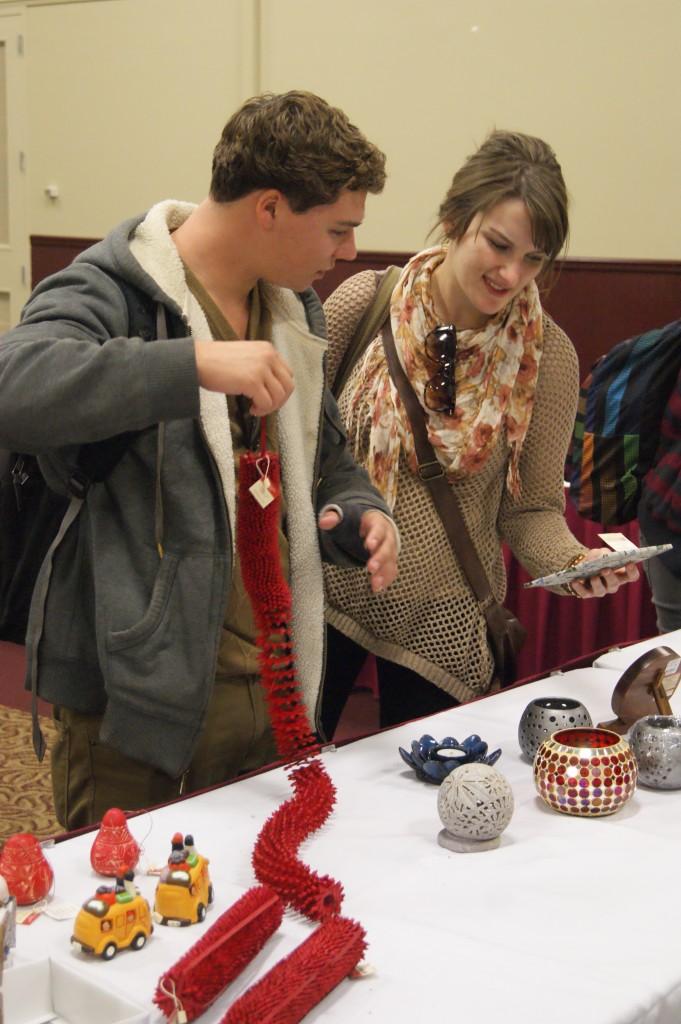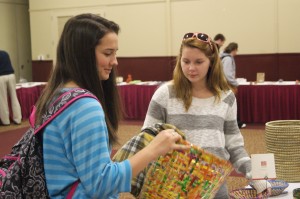
The IUS community traveled abroad and experienced international lifestyles by visiting the Hoosier Room during the annual Wares of the World event.
Hosted by the International Program, the event took place on Oct. 10 and 11 and featured an array of fair trade items from across the world, including jewelry from Peru, purses from Guatemala and scarves from Nepal.
The items were provided by Ten Thousand Villages, a fair trade retailer that creates a market for artisan products to be sold.
Valerie Scott, senior lecturer in psychology and co-director of the International Programs, said the importance of fair trade is acknowledging the ability of people to produce items for survival.

“First of all, it raises awareness that even people in developing countries can be creative, artistic and understand beauty,” she said. “Another, more economical, lesson is that actually those people take into their hands the ability to provide for themselves.”
The cost of the merchandise ranging from $1.50 to almost $60. In addition, 95 percent of the total proceeds went to the artisans and 5 percent helped with the cost of the International Programs and study abroad scholarships.
Kathryn Pask, psychology senior, volunteered for the event and has studied abroad in Uganda.
She said she appreciated seeing the different types of products from across the world.
“I feel that this is a wonderful opportunity to share some cultural experiences that you might not have had living in Southern Indiana,” Pask said.
Many students arrived at Wares of the World due to a First-Year Seminar requirement to attend a social and cultural event.
While this was the case for Amber Medlock, undecided freshman, she said the event caught her attention after seeing someone walking around with a basket from Bangladesh, which was made out of candy wrappers.
“I was just really impressed with that, so I thought I would stop in during lunch,” Medlock said. “I keep walking over to that basket that’s made out of candy wrappers. I actually have a bag made like that.”
However, Medlock said she decided to purchase a pair of purple earrings instead.
The candy basket attracted another student, Michelle Wells, psychology freshman, who said she was also interested in a hippopotamus statue and soaps made from India. Likewise, Wells attended the event due to an FYS class.
“I pretty much like little knick-knacks, and I didn’t really know what [the event] was about, but my psychology teacher told me,” Wells said.
Wells said she thinks it is important for students to experience different cultures other than their own.

“We’re kind of just stuck in a small town where we don’t really meet new people unless we go out of state,” she said. “I’ve kind of been stuck in a closet my whole life it feels like.”
Finda Nessy, nursing freshman, said, while she went to Wares of the World for a geography class, she also found a personal connection to the event.
Nessy’s parents are from Liberia, and she said she recognized a Liberian instrument for sale, which was similar to one her late aunt sent her.
“There’s just a lot of culture around here, and culture is a good thing,” Nessy said.
Megan Jones, psychology senior, said she heard about the event from her professor during class and decided to buy a Nicaraguan candle holder in the shape of an owl.
Jones said she thinks people need to be better-rounded and can do this by experiencing other cultures.
“I think it’s important to keep an open mind because we have a lot of people in our country who know nothing about other countries,” Jones said.
Medlock said she was amazed by how each culture used everyday objects to create the items.
“I’ve noticed from each little section that I’ve moved to that each one has had a different perspective,” Medlock said. “Whether it’s a color scheme or perceptions of the people or animals, they’re completely different in the shapes and sizes.”
By immersing in other cultures, Nessy said it helps to understand and provide perspective on different lifestyles.
“I think that it is very important for people to experience culture because there are just so many different types, and it’s just a learning experience,” Nessy said. “You can learn a lot from somebody else who is from someplace else.”
By CLAIRE MUNN
Senior Editor
clamunn@umail.iu.edu
[photospace]






